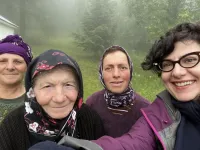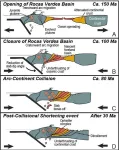(Press-News.org) Galaxies start life with their stars rotating in an orderly pattern but in some the motion of stars in more random. Until now, scientists have been uncertain about what causes this – possibly the surrounding environment or the mass of the galaxy itself.
A new study, published in a paper today in MNRAS (Monthly Notices of the Royal Astronomical Society), has found that the most important factor is neither of these things. It shows the tendency of the stars to have random motion is driven mostly by the age of the galaxy – things just get messy over time.
“When we did the analysis, we found that age, consistently, whichever way we slice or dice it, is always the most important parameter,” says first author Prof Scott Croom, an ASTRO 3D researcher at the University of Sydney.
“Once you account for age, there is essentially no environmental trend, and it’s similar for mass.
“If you find a young galaxy it will be rotating, whatever environment it is in, and if you find an old galaxy, it will have more random orbits, whether it’s in a dense environment or a void.”
The research team also included scientists from Macquarie University, Swinburne University of Technology, the University of Western Australia, the Australian National University, the University of New South Wales, the University of Cambridge, the University of Queensland, and Yonsei University in the Republic of Korea.
The study updates our understanding from previous studies that have variously suggested environment or mass as more important factors. But the earlier work is not necessarily incorrect, says second author Dr Jesse van de Sande.
Young galaxies are star-forming super-factories, while in older ones, star formation ceases.
“We do know that age is affected by environment. If a galaxy falls into a dense environment, it will tend to shut down the star formation. So galaxies in denser environments are, on average, older,” Dr van de Sande says.
“The point of our analysis is that it’s not living in dense environments that reduces their spin, it’s the fact that they’re older.”
Our own galaxy, the Milky Way, still has a thin star forming disk, so is still considered a high spin rotational galaxy.
“But when we look at the Milky Way in detail, we do see something called the Milky Way thick disk. It’s not dominant, in terms of light, but it is there and those look to be older stars, which may well have been heated from the thin disk at earlier times, or born with more turbulent motion in the early Universe,” Prof Croom says.
The research used data from observations made under the SAMI Galaxy Survey. The SAMI instrument was built in 2012 by the University of Sydney and the Anglo-Australian Observatory (now Astralis). SAMI uses the Anglo-Australian Telescope, at Siding Spring Observatory, near Coonabarabran, New South Wales. It has surveyed 3000 galaxies across a large range of environments.
The study allows astronomers to rule out many processes when trying to understand galaxy formation and so fine-tune models of how the Universe has developed.
The next steps will be to develop simulations of galaxy evolution with more granular detail.
“One of the challenges of getting simulations right is the high resolution you need in to predict what's going on. Typical current simulations are based on particles which have the mass of maybe 100,000 stars and you can't resolve small-scale structures in galaxy disks,” Prof. Croom says.
The Hector Galaxy Survey will help Prof Croom and his team expand this work using a new instrument on the Anglo-Australian Telescope.
“Hector is observing 15,000 galaxies but with higher spectral resolution, allowing the age and spin of galaxies to be measured even in much lower mass galaxies and with more detailed environmental information,” says Professor Julia Bryant, lead of the Hector Galaxy Survey, University of Sydney.
Professor Emma Ryan-Weber, Director of ASTRO 3D, says, “These findings answer one of the key questions posed by ASTRO 3D: how does mass and angular momentum evolve in the Universe? This careful work by the SAMI team reveals that the age of a galaxy determines how the stars orbit. This critical piece of information contributes to a clearer big-picture view of the Universe.”
ABOUT ASTRO 3D
The ARC Centre of Excellence for All Sky Astrophysics in 3 Dimensions (ASTRO 3D) is a $40m Research Centre of Excellence funded by the Australian Research Council (ARC) and nine collaborating Australian universities – The Australian National University, The University of Sydney, The University of Melbourne, Swinburne University of Technology, The University of Western Australia, Curtin University, Macquarie University, The University of New South Wales, and Monash University.
ABOUT the SAMI Galaxy Survey
The SAMI Galaxy Survey began in March 2013, with the intention of creating a large survey of 3000 galaxies across a large range of environment. The data for the SAMI Galaxy Survey was collected using SAMI, the Sydney-Australian-Astronomical-Observatory Multi-object Integral-Field Spectrograph. SAMI is an instrument on the 4-meter Anglo-Australian Telescope at Siding Spring Observatory. Integral-field spectroscopy (IFS) allows a unique view of how stars and gas zoom around inside distant galaxies because we collect dozens of spectra across the entire face of each galaxy.
END
Galaxies get more chaotic as they age
An international team led by Australian research centre ASTRO 3D reports that age is the driving force in changing how stars move within galaxies
2024-04-03
ELSE PRESS RELEASES FROM THIS DATE:
Sandia pumps $140B into the economy through technology development
2024-04-03
ALBUQUERQUE, N.M. — To say that the technology and products Sandia National Laboratories researchers have helped imagine, innovate and industrialize have had a massive impact on the country would be an understatement.
Two studies commissioned by Sandia and the National Nuclear Security Administration show Sandia’s work has had an overall economic impact of $140 billion since the year 2000. That’s a significant figure, especially considering it spans just 20 years, less than a third of Sandia’s 75-year existence.
“I am very proud of how Sandia excels in fulfilling its technology transfer mission to deliver economic impact to the U.S.,” ...
Even moderate alcohol usage during pregnancy linked to birth abnormalities, UNM researchers find
2024-04-03
University of New Mexico researchers have found that even low to moderate alcohol use by pregnant patients may contribute to subtle changes in their babies’ prenatal development, including lower birth length and a shorter duration of gestation.
In a new paper published in the journal Alcohol Clinical & Experimental Research, a team led by Ludmila Bakhireva, MD, PhD, MPH, professor and assistant dean for Clinical and Translational Research in the UNM College of Pharmacy, also reported some sex-related differences in the effects of drinking during pregnancy on the developing ...
Sylvester physician co-authors global plan to combat prostate cancer
2024-04-03
MIAMI, FLORIDA (EMBARGOED UNTIL APRIL 4, 2024, at 6:30 pm EDT) – Annual prostate cancer cases worldwide are projected to double by the year 2040, and annual deaths are projected to increase by 85% to almost 700,000 over the same timeframe – mainly among men in low- and middle-income countries. A commissioned report published online in The Lancet on April 4 highlights the future landscape of prostate cancer and seeks to guide cancer experts worldwide on how to manage the massive influx of prostate cancer patients projected over the next two decades.
Brandon Mahal, M.D., radiation oncologist and ...
Last chance to record archaic Greek language ‘heading for extinction’
2024-04-03
A new data crowdsourcing platform aims to preserve the sound of Romeyka, an endangered millennia-old variety of Greek. Experts consider the language to be a linguistic goldmine and a living bridge to the ancient world.
The initiative, led by Professor Ioanna Sitaridou from the University of Cambridge, contributes to the UN’s International Decade of Indigenous Languages (2022-32), which aims ‘to draw global attention on the critical situation of many indigenous languages and to mobilise stakeholders and resources for their preservation, revitalization and promotion.’
Romeyka is thought to have only a couple of thousand ...
Chicks prove vision and touch linked at birth
2024-04-03
Newly hatched chicks raised in darkness and allowed to touch either a smooth or bumpy cube for 24 hours instantly recognised the object with their vision upon first exposure to light.
This suggests chicks can link touch and vision without any prior experience combining these senses, challenging the long-held belief that such integration requires learning.
The discovery implies a pre-wired ability in the brain for cross-modal perception, potentially redefining our understanding of animal cognition and sensory processing.
In a study published in Biology Letters, researchers at Queen Mary University of London have cracked ...
Researchers propose new step in tectonic squeeze that turns seafloor into mountains
2024-04-03
Scientists use tiny minerals called zircons as geologic timekeepers. Often no bigger than a grain of sand, these crystals record chemical signatures of the geological environment where they formed. In a new study led by scientists at The University of Texas at Austin, researchers used them to describe what could be an overlooked step in a fundamental tectonic process that raises seafloors into mountains.
In a study published in the journal Geology, the researchers describe zircons from the Andes mountains of Patagonia. Although the zircons formed when tectonic plates were colliding, they have a chemical signature associated ...
Gut bacteria that strongly influence obesity are different in men and women, study finds
2024-04-03
Novel approach finds gut microbiota that are highly predictive of BMI, waist circumference, and fat mass are different in men and women
And might change the chemical makeup (metabolome) of the gut in ways that affect the metabolism of different bioactive molecules that influence metabolic disease development
Interventions to help prevent obesity-favourable microbiome may need to be different in men and women
*This is an early press release from the European Congress on Obesity (ECO 2024) Venice 12-15 May. Please credit the Congress if using this material*
New research being presented at this year’s European ...
Double trouble: the risks of mixing alcohol and sports wagering
2024-04-02
It turns out that money isn’t the only thing sports gamblers are risking. According to a new study, bettors who wager on sporting events, esports, and daily fantasy sports are much more likely than other individuals to binge drink.
The findings, compiled by a research team from UNLV and the University of New Mexico, were published this week in the journal JAMA Network Open.
Over the course of three weeks in spring 2022, researchers surveyed more than 4,300 adults across the U.S. Nearly 3,300 self-reported past year alcohol use, while about 1,800 identified themselves as gamblers who had bet on sports in the past year.
Researchers ...
Far-UVC light can virtually eliminate airborne virus in an occupied room
2024-04-02
NEW YORK, NY--Far-UVC light is a promising new technology for reducing airborne virus levels in occupied indoor spaces, but its effectiveness has not been evaluated in real-life scenarios.
A new study by Columbia researchers now shows that far-UVC light inactivated nearly all (>99%) of an airborne virus in an occupied work environment, showing that the technology can work as well in a real-life scenario as in the laboratory.
“The results show that far-UVC is highly effective at reducing airborne pathogens in an ordinary occupied room, and so it’s practical to use far-UVC light in indoor areas where people are going about their business,” says David ...
A new estimate of U.S. soil organic carbon to improve Earth system models
2024-04-02
Soil contains about twice as much carbon as the atmosphere and plants combined. It is a major carbon sink, capable of absorbing more carbon dioxide from the atmosphere than it releases. Management of soil carbon is key in efforts to mitigate climate change, in addition to being vital to soil health and agricultural productivity.
Measuring soil carbon, however, is a painstaking, expensive process. Samples must be dug from the ground and sent to a lab for analysis, making upscaling measurements on a large spatial scale ...
LAST 30 PRESS RELEASES:
There are new antivirals being tested for herpesviruses. Scientists now know how they work
CDI scientist, colleagues author review of global burden of fungus Candida auris
How does stroke influence speech comprehension?
B cells transiently unlock their plasticity, risking lymphoma development
Advanced AI dodel predicts spoken language outcomes in deaf children after cochlear implants
Multimodal imaging-based cerebral blood flow prediction model development in simulated microgravity
Accelerated streaming subgraph matching framework is faster, more robust, and scalable
Gestational diabetes rose every year in the US since 2016
OHSU researchers find breast cancer drug boosts leukemia treatment
Fear and medical misinformation regarding risk of progression or recurrence among patients with breast cancer
Glucagonlike peptide-1 receptor agonists and asthma risk in adolescents with obesity
Reviving dormant immunity: Millimeter waves reprogram the immunosuppressive microenvironment to potentiate immunotherapy without obvious side effects
Safety decision-making for autonomous vehicles integrating passenger physiological states by fNIRS
Fires could emit more air pollution than previously estimated
A new way to map how cells choose their fate
Numbers in our sights affect how we perceive space
SIMJ announces global collaborative book project in commemoration of its 75th anniversary
Air pollution exposure and birth weight
Obstructive sleep apnea risk and mental health conditions among older adults
How talking slows eye movements behind the wheel
The Ceramic Society of Japan’s Oxoate Ceramics Research Association launches new international book project
Heart-brain connection: international study reveals the role of the vagus nerve in keeping the heart young
Researchers identify Rb1 as a predictive biomarker for a new therapeutic strategy in some breast cancers
Survey reveals ethical gaps slowing AI adoption in pediatric surgery
Stimulant ADHD medications work differently than thought
AI overestimates how smart people are, according to HSE economists
HSE researchers create genome-wide map of quadruplexes
Scientists boost cell "powerhouses" to burn more calories
Automatic label checking: The missing step in making reliable medical AI
Low daily alcohol intake linked to 50% heightened mouth cancer risk in India
[Press-News.org] Galaxies get more chaotic as they ageAn international team led by Australian research centre ASTRO 3D reports that age is the driving force in changing how stars move within galaxies





